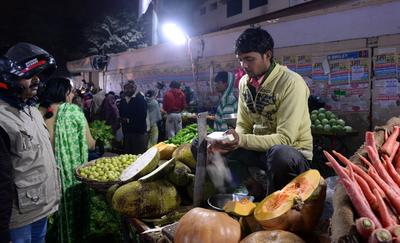The Economist Intelligence Unit forecasted 2013 real GDP growth to be a mere 4.9 per cent with industrial decline by 1.4 per cent, not to mention an unemployment rate of 8.8 per cent. In 2014 GDP growth is forecasted to recover to 6 per cent.
At the same time, despite its pressing need, the investment climate has deteriorated. According to the Planning Commission, gross domestic capital formation fell from 36.84 per cent of GDP in 2010–11 to 35 per cent in 2011–12, and was forecasted to be only marginally higher at 35.4 per cent in 2012–13. Meanwhile, gross domestic savings fell from 34.02 per cent of GDP in 2010–11 to 30.81 per cent in 2012–13 and is projected to recover only to 31.8 per cent.
Between 1 April 2012 – 30 September 2012, on the one hand, and 1 April 2013 – 30 September 2013 on the other, FDI equity inflows fell by 4 per cent in rupee terms and 11 per cent in dollar terms. It has been reported that in 2012–13 India attracted US$26.9 billion in FDI inflows while outflows totalled around US$26 billion. The minor surplus of inward FDI was of course no reason to rejoice for an economy that has been reported to need US$1 trillion in infrastructural investment alone.
This lackadaisical performance with respect to investment is reflected in production data, especially for key inputs like coal for power generation. Even though India has one of the world’s largest coal reserves it is increasingly relying on coal imports. Again, according to the Planning Commission, between 1 April 2012 – 31 March 2013, India imported 20 per cent of its coal requirement. This is expected to rise to more than 23 per cent by 2017. Indeed, India is expected to overtake China as the world’s largest coal importer.
The relative reduction in domestic coal production reflects difficulties in the granting of mining licenses, particularly because of an alleged scam whereby mining licenses were granted without auctions. India’s coal import policies are probably already affecting the marginal price of coal it faces in international markets. This, of course, exacerbates an already difficult current account balance and hence puts upward pressure on policy interest rates.
Natural gas does not present an optimistic picture either, beset as it is with pricing problems. The BP Statistical Review of World Energy reports that natural gas production in India declined at the fastest pace of all Asian countries in 2012, even as China’s gas production increased by 9.9 per cent. Similarly, US gas production increased in 2012 by 4.1 per cent, the highest in two years.
Against this background, can a rebound in growth to 6 per cent in 2014, as indicated by a number of commentators, really be expected? The principal reason for this optimism is rising rural prosperity.
A number of factors are contributing to rising rural prosperity. The first is consecutive years of good monsoons — at least half of India’s population relies on the largely rain-fed agricultural sector for a living. With only three major droughts recorded between 2002 and 2012, agricultural incomes have grown fairly steadily over the last decade, aided by generous support prices for agricultural products. National Sample Survey Office data shows that between 2010 and 2012 incomes have risen (in nominal terms) by 35.7 per cent in the rural sector compared to 32 per cent in the urban sector. Further, the rural sector is also being diversified away from food to many industrial products and services, indicative that rising rural incomes are providing support to non-agricultural growth. Aiding this is the sharp rises in rural sector wages, some of which are due to programs under the Mahatma Gandhi National Rural Employment Guarantee Act. This rising rural prosperity is the principal reason underpinning a more optimistic outlook for the Indian economy in 2014.
But some caveats are in order. The rise of rural wages may be unrelated to productivity increases given the large infusion of funds. So the rise in wages might provide a short-term fillip to the growth rate but, unless strong efforts are made to improve supply conditions, this might lead to further increases in inflation, and therefore interest rates, acting as a drag on industrial growth.
As such, improving supply conditions are central to augmenting India’s growth rate in 2014 and beyond. At the minimum this would involve two factors. First, better management of the vast grain stocks, which will grow even bigger once the current crop is harvested. If this is managed well CPI inflation will fall, leading ultimately to a drop in WPI inflation and thus interest rates. Second, provision of energy (coal) licenses must be streamlined and there should be enhanced production of energy from domestic sources. If these two policy steps are undertaken, extant factors facilitating high economic growth for India in the long run should ensure sustained high economic growth.
Raghbendra Jha is Professor of Economics and Executive Director at the Australia South Asia Research Centre, Australian National University.
This article is a part of an EAF special feature series on 2013 in review and the year ahead.

